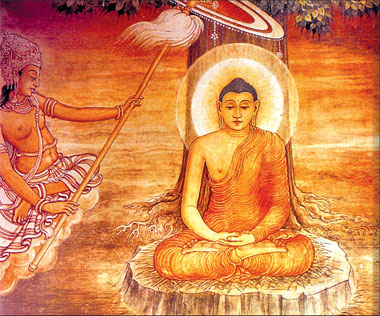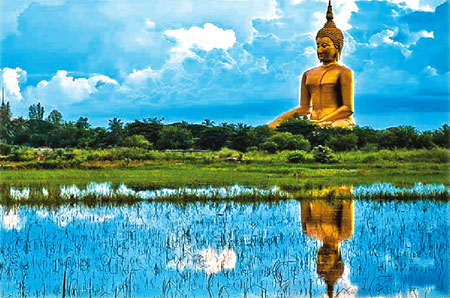|
Buddhist Spectrum
Lanka blessed by the living Buddha
Rupa BANDUWARDENA
Supreme enlightened one, Sakyamuni Siddhartha Gauthama delivered his
supreme gift of Dhamma to one and all. His words of compassion comforted
thousands who listened to his Dhamma. Wherever the Buddha’s feet touched
the soil of India, Buddhism gained ground rapidly. To propagate the
Dhamma, Buddha walked through the streets and enlightened millions of
his ardent devotees.

In early days, the Buddha and his disciples had no fixed abode but
lived in parks and forests or caves. Later, when the Veluwanarama was
built and offered by the royalty, the Buddha and his disciples lived
more in them. Veluvanarama is believed to be the first monastery in the
history of Buddhism that was donated exactly on the Duruthu Poya day. On
the ninth month of his enlightenment, the Buddha turned his attention to
Sri Lanka which made it to be identified as Dharmadweepa.
When and where and how was the Great Master Sakyamuni Siddhartha
Gauthama appear in Sri Lanka? Early chronicles throw light on Buddha’s
first visit to Mahiyangana and it remains the greatest sacred monument
of the Buddhist.
The earliest chronicles, Deepawamsa, Mahawamsa and Samanthapasadica
give a vivid description of the sacred visits of Thathagatha. History
records that sakyamuni arrived at Mahiyangana, where the inhabitants
belonged to various types such as Yakka and Naga.
They were not at all happy to see a saintly figure like the Buddha
who with his Metta and Dhamma was able to win them over for their own
good. Having listened to his Dhamma, they worshiped the Buddha with
great love. Since his only wish was the happiness and welfare of all
beings in their upward path, they were well subdued.
Here the Buddha established the idea of brotherhood of all living
beings and its aim of peaceful coexistence and the newly converted
tribes showed profound devotion and respect. It is said that they were
later driven away to Girideepa.
First Chetiya
This is not all. Listening to his sermons Dewamahasumana appeared on
the scene. History reveals that Sakyamuni on his first visit to
Mahiyangana had given a handful of hair to Devamahasumana at his
request.
The overjoyed Deva placed it in a golden casket and later enshrined
it in the Stupa which later came to be called Mahiyangana Chaitya – the
greatest event of great historical importance in Sri Lankan Buddha
Sasana.
Hence the honour of laying the foundation for the first Chaitya in
Dharmadweepa goes to Dewamahasumana. This is given much significance
because it was the first built here in Sri Lanka. Moreover, it was built
by a divine being on the spot where the Buddha made his first visit to
the island.
It is believed that the royalty gave their support and patronage at
various times to build up this sacred spot blessed by the Buddha. After
the Parinibbana of the Buddha and the distribution of the sacred relics,
Greevadathu (neck relic) had been brought to Sri Lanka by Arahat Sarabhu,
a pupil of Ven. Sariputta and enshrined in the same Stupa. It is said to
have been completed in several stages. The original Stupa begun by
Dewamahasumana was later improved by king Uddachulabhaya, king
Dutugemunu which stands as a testimony to his lasting contribution to
Buddhism.
New Phase
History of Buddhism is said to go back to the time of the Buddha
visiting the island long before the introduction of Buddhism by
Venerable Arahath Mahinda even before the arrival of Vijaya who is said
to have landed here on the day of the Parinibbana. A new phase begins in
our tradition with the visit of the Buddha. Our heritage rests firmly on
the foundation of Buddhism which has been preserved and practiced.
Buddha’s visits are considered as a precious gift to Buddhist
heritage adding wonderful events, happened during the time of living
Buddha which could be considered even more important than
Mahindagamanaya.
The foundation was then laid for our ancient culture based on
Buddhism inspired by Buddhist ideals. What more? Thus, Sri Lanka had the
good fortune of being blessed with the presence of the living Buddha.
Sixteen places had been blessed by him as he was well aware that
Buddhism was to flourish in this Dharmadweepa – the most sacred event in
human history.
Jaffna’s Buddhist revival
Priyanka Kurugala
Various activities have commenced in Naga Vihara, Jaffna. Since 1996,
which was when Jaffna was liberated from the LTTE clutches, the temple
has been a hive of religious activities.

Offering alms Pictures by Ruwan de Silva |

Religious harmony |
Naga Vihara could commence Katina Pooja in 1999. Roads were open to
the public following the humanitarian victory in 2009. The Nagavihara
Katina Perahera commenced, opening a peaceful environment.
In 3rd BC Arahath Sangamiththa Therani brought the sapling of the
Sacred Jaya Srimaha Bodi to the country through harbor -Dambakolapatuna
which is situated in the Northern part of the country. At that time,
King Devanampiya Tissa ruled the country. According to chronicle in the
country King Devanampiya Thissa warmly welcomed the sapling of the
Sacred Jaya Sri Maha Bodhi and worshiped with his officers and civilians
paying state honors to the sapling of the Jaya Sri Maha Bodhi.
Sacred temple
During this period, the Nagas lived in the northern region. Thus the
region was called ‘nagadeepa’. According to Nagas’ request, it is
recorded, King Devanampiyatissa supplied facilities to worship the
sapling of Jaya Sri Maha Bodhi for one week.
|

Usual Jaffna life |
The people had then built a sacred temple and named it Naga Vihara.
Buddhist monks started performing various rituals under the sponsorship
of the king. This came to a halt during the LTTE reign.
Following the 2009 victory, Naga Vihara monks could come forward to
protect the Buddhist site. The Katina ritual had the participation of
Tamils and Sinhala alike along with armed forces even amid heavy rains.
Thousands of people are now paying homage to this ancient temple. The
religious harmony is present as the crowds revere Nalloor Kovil
activities as well. There could not be a better process to establish
religious harmony than this.
According to Naga Vihara’s Chief Incumbent Ven Siri Wimala Thera, 48
dancing troops participated in the Perahera programme with 62 cultural
events included in the programme. The dancing was both Kandyan as well
as Tamil.
|

Young devotees |
Jaffna Ranga Arts Centre played an instrumental role in contributing
to the perahera ceremony with its student. Gangarama Chief Incumbent Ven
Galaboda Ghanessara Thera supplied an elephant for the Perahera
ceremony.
The Nagavihara temple Katina religious activities were held under the
patronage of the Nagavihara Chief Incumbent Ven Meegahajandure
Ghanarathane Thera, while a number of monks participated from many areas
of the country.
Brigadier Chandana Gunawardana and Brigadier D B Randeniya also took
a part in this religious ceremonial event. The Katina religious
programme consisted of many religious activities. Perahera programme,
Kathina Cheewara Pooja, Bodhi Pooja, all night Pirith chanting ceremony
and alms giving religious activities have been included.
All religious activities were conducted by the Sri Nagavihara
Development Foundation – Jaffna and the Tamil Buddhist Association with
the assistance of three forces.
Tamil Buddhist Association President A Ravi Kumar directed children
in Nandarama Tamil Dhamma School towards Perahera programme. Jaffna
Mayor Yogeshwari Pathgunaraja Northen Province Governor G A Chandrasiri
supported the Nagavihara programme.
Pleased with the greatest thing in the World
Venerable Nawalapitiye Ariyawansa Thera
The Buddha teaches us that if somebody expects the greatest result,
he must be pleased with the greatest thing. If one is pleased with the
greatest thing in the world, he can enjoy the greatest result. The
Buddha shows four sublime facts for us to be pleased with. (The greatest
thing in the world).
The Buddha shows us that the Buddha is the greatest among all beings
in the world. If somebody is pleased with the Buddha who is the greatest
among all beings, he can acquire the greatest results. Greatest results
mean, he can enjoy the greatest happiness.

If there is any Sankatha Dhamma (something that arises due to a
certain cause and when the cause disappears, the result or effect also
disappears) in the world, among such things the way to Nibbana is the
greatest.
That is the eight noble path. If anybody is pleased with the eight
noble path, he has the opportunity to acquire the greatest results. The
greatest results mean the greatest happiness.
At the same time, the Buddha shows that if there is any Asankatha
things among Sankatha Dhamma, Nibbana is the greatest. If somebody is
pleased with the Nibbana, the greatest among Asankatha Dhamma, he also
can acquire the greatest results. The greatest result means the
opportunity to enjoy happiness.
At the same time, The Buddha shows that among all groups, Buddha’s
disciples are the greatest. The Buddha shows us that if anyone can be
pleased with Buddha’s disciples, he can acquire the greatest results.
If somebody is pleased with the greatest thing in the world, he has
definitely the chance to be happy.
If somebody is pleased with the Buddha, he is pleased with the noble
person who is endowed with the greatest virtues. One who is pleased with
such a noble person, begins to purify his mind. That is the beginning of
purification of the mind.
If somebody is pleased to follow the path to Nibbana, he has the
ability to practice the path to Nibbana. If someone keeps on following
the path to Nibbana, he will be rewarded with happiness. If someone is
pleased with Nibbana, he develops a liking to do away with demerits (Akusal)
and develop merits (Kusal). In this way, he will be rewarded with
happiness.
If he is pleased with the disciples of the Buddha, he has the chance
to listen to Dhamma, offer alms and know about virtues (Seela). By being
pleased with the Sanga, he develops the opportunity to know the ways and
means to enjoy pleasure.
If somebody is pleased with the most noble thing of the world, he is
sure to get the chance of enjoying the happiness of the world. So, we
must be well aware of the Dhamma in the world in order to be pleased
with the noble Dhamma. Then only we will understand that it is the most
noble Dhamma in the world. If we could understand the greatness of
Dhamma, we will be able to be pleased with it. Let’s be fortunate enough
to learn the Dhamma preached by the Buddha, and be pleased with the
Dhamma and enjoy the greatest happiness.
Translated by M.A Samarsinghe
Katina Perahera
* Nandaram Tamil Buddhists Dhamma Schoolchildren -Buddhists flags
* St. Joshep College Madagal in Jaffna - Pot dancing (Kalagedi Netuma)
* Nilshala Arts Centre, Kandy - Peacock dancing
* Thalapiya Arts Centre, Jaffna - Pot dancing
* Kalaguru Ananda Dharmasiri, Rajanganaya - Kandyan Wes
Dancing troupe
* Welanai Central College, Jaffna - Leekeli Netuma
* Balendran Arts Centre, Jaffna – Mahabamba Thelippale Mahajana Vid
dhyala, Jaffna - Sri Lakshmi Deve Matha |







